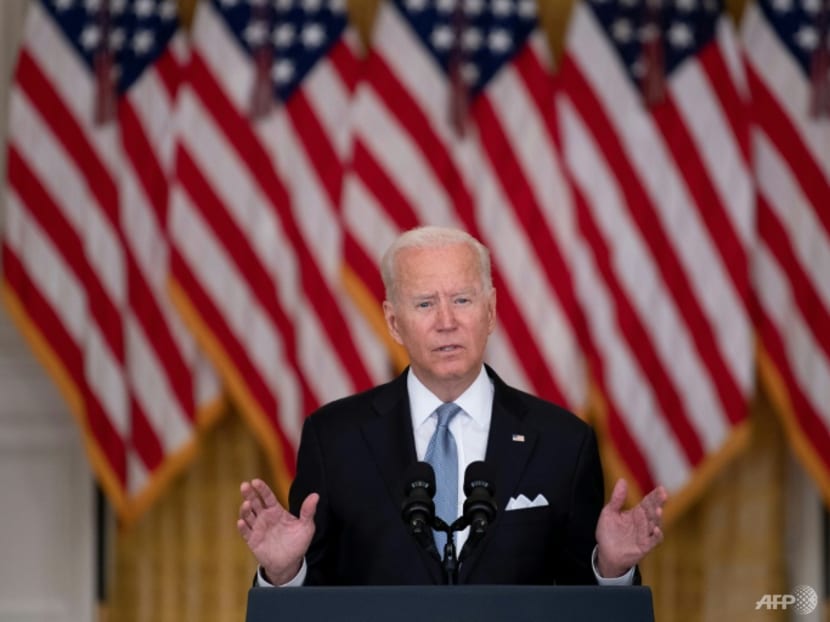Commentary: Why the US could not protect Afghanistan from the Taliban
A vacuum of political will and strategic missteps provided the Taliban an opportunity to launch an insurgency that ultimately resulted in its return to power, says Yale-NUS College’s Dr Navin Rajagobal.

US President Joe Biden pushed ahead with the withdrawal from Afghanistan, even as he acknowledged chaotic scenes after the Taliban takeover were "gut-wrenching". (Photo: AFP)
SINGAPORE: Two weeks before the United States was set to complete troop withdrawal, the Taliban seized power in Afghanistan.
This outcome was not unexpected. And yet, the lightning speed at which events unfolded has been disturbing for the US, its allies and the international community.
In just days, the Afghan military and government, which the international community invested so much in and sacrificed so much for over the past 20 years, disintegrated.
On Monday (Aug 16), Kabul fell without a fight as the Taliban entered the city and President Ashraf Ghani fled the country.
US President Joe Biden’s decision to withdraw the nominal US and NATO presence in Afghanistan was only the latest in a series of missteps that allowed the Taliban to return to power.
The planned US departure near the 20th anniversary of the 9/11 attacks now looks like a repudiation of the last 20 years.
Interpreters, Afghan staff and activists have been abandoned with few given refuge. Scenes of the airport packed with desperate mobs hoping to flee and embassy staff being evacuated have conjured up comparisons with 1975 Saigon.
DIVIDED FOCUS, WANING OF POLITICAL WILL
The US and its allies had 20 years to neutralise the Taliban. They couldn’t. Like the British Raj and the Soviet Union, the US found that invading Afghanistan is easy, but the ensuing occupation demanding.
It could have learnt better why Afghanistan has been infamously described as the “graveyard of empires” before its 2001 invasion. The difficult mountainous terrain, porous international borders, shifting tribal loyalties, and contending regional powers meant that anything less than total commitment to defeating the Taliban would not suffice.
Not long after invading Afghanistan in 2001 in pursuit of Osama bin Laden and Al Qaeda in the wake of 9/11, the US was distracted by a controversial invasion of Iraq and the pursuit of Saddam Hussein.
A superpower could, in theory, conduct major overseas military operations in more than one country, and even hold its ground in more than one theatre of operations.
Yet there can be no doubt that the two concurrent, long-drawn conflicts, plus the wider War on Terror, divided the coalition’s resources and sapped the will of the American public to risk American lives in the longer term. All while the US awoke to the reality of a resurgent Russia and a rising China, and the need to refocus on the Asia-Pacific.
This vacuum of political will and strategic focus provided the Taliban an opportunity to regroup and launch an insurgency that ultimately resulted in its return to power.
THE PAKISTAN FACTOR
The US failed to decisively tackle support for the Taliban from Pakistan during their 20-year occupation of Afghanistan.
The Taliban would not have been so resilient and successful, if not for support emanating from Pakistan.
The Taliban leadership could base itself in Pakistani cities. Taliban militants could use the Pakistani border as staging areas for guerrilla attacks.
The lack of trust between US forces in Afghanistan and Pakistan was evident when the US’ 2011 secret operation from Afghanistan to Pakistan to neutralise Osama bin Laden was not made known to the Pakistanis beforehand.
A LIGHTNING OFFENSIVE
The Taliban have been very adept at asymmetric warfare. For example, unlike the Afghan military, the Taliban lacked an air force. Hence their tactic was to assassinate Afghan air force pilots on the ground in hit-and-run operations.
Conversely, the coalition and the Afghan military could not bring to bear their numerical and technological advantage against the Taliban.
This was how the Taliban played the long game and waited for the US to tire.
In fact, the Taliban’s specific strategy in their swift offensive against the more numerous, better equipped and Western-trained Afghan military, is worth studying.
The Taliban first consolidated their hold over regional areas, attacked strategic and lucrative border points, and seized northern regions that had traditionally hosted the anti-Taliban resistance. They then encircled smaller towns and regional capitals, and finally isolated and captured Kabul with relative ease.
On the other hand, the bulk of the Afghan military put up little of a fight. Instead, they adopted the curious strategy of retreating into towns and cities, and finally became resigned to the idea of an eventual Taliban victory.
MISSED OPPORTUNITIES FOR REAL PEACE AND RECONCILIATION
Negotiating from a position of strength is always preferable to the opposite. The US had a military that could project overwhelming power and force the Taliban to the table.
So why did it take nearly two decades for the peace effort to commence in earnest? Were the US and their allies too focused on a military solution?
There were missed opportunities for an early power-sharing arrangement when the Taliban was relatively weak. A Carnegie Endowment report suggests early Taliban peace overtures after the US invasion had been snubbed.
The 2020 agreement between the US, under then President Donald Trump and the Taliban, was deeply flawed. Intended to offer safe passage and legitimacy to exiting forces, the agreement, which excluded the Afghan government, committed the US and its allies to withdraw with a fixed date, but did not stop the Taliban from further violence in Afghanistan.
Some argue President Biden’s hands were tied by this deal that obligated the US to leave. Not following through could have accelerated the Taliban’s attacks on remaining coalition forces.
And yet the Taliban’s escalation of violence against the Afghan people could have been just cause for the US to delay withdrawal.
The US could have insisted on the Taliban’s full commitment to the peace process and compelled them to cease their actions. United Nations reports have highlighted increasing Taliban violence against the Afghan government and civilians, but this was ignored.
A STRATEGIC BLUNDER
Clearly, the US did not fathom that the Afghan military and government would collapse so quickly. This is either a massive failure of intelligence or a strategic blunder. The latter looks likely since the US military and intelligence warned that the Afghan government could be toppled at some point in the near future.
Perhaps the Biden administration concluded staying on was never in the national interest of the US, and the focus should be America’s strategic competitors, China and Russia. This explains why the US and its allies did very little militarily to stop the Taliban’s rapid momentum toward Kabul.
Perhaps they also took into consideration that the ousted Afghan government had a serious credibility issue with the Afghan people. Disputed elections, allegations of corruption and infighting in the Afghan government contrast with what seems like unity and single-minded purpose within the Taliban.
So could the second fall of Afghanistan to the Taliban have been avoided? This is a question analysts and scholars will be studying for a long time to come.
Dr Navin Rajagobal is Senior Lecturer, Global Affairs and Director, Academic Affairs at Yale-NUS College in Singapore.
The views and opinions expressed herein are those of the author and do not represent the views and opinions of Yale-NUS College or any of its subsidiaries or affiliates.











